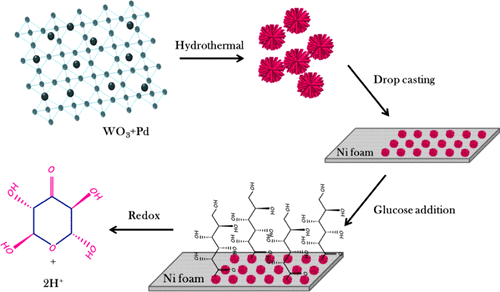当前位置:
X-MOL 学术
›
J. Phys. Chem. B
›
论文详情
Our official English website, www.x-mol.net, welcomes your
feedback! (Note: you will need to create a separate account there.)
Pd-Doped WO3 Nanostructures as Potential Glucose Sensor with Insight from Electronic Structure Simulations
The Journal of Physical Chemistry B ( IF 2.8 ) Pub Date : 2018-02-19 00:00:00 , DOI: 10.1021/acs.jpcb.7b11642 Rajeswari Ponnusamy 1 , Brahmananda Chakraborty 2 , Chandra Sekhar Rout 1, 3
The Journal of Physical Chemistry B ( IF 2.8 ) Pub Date : 2018-02-19 00:00:00 , DOI: 10.1021/acs.jpcb.7b11642 Rajeswari Ponnusamy 1 , Brahmananda Chakraborty 2 , Chandra Sekhar Rout 1, 3
Affiliation

|
Herein, we report the results of crystal-structure-dependent nonenzymatic glucose-sensing properties of tungsten oxide (WO3) and Pd-doped WO3 nanostructures. The WO3 nanomaterials with orthorhombic, monoclinic, and mixed (ortho + monoclinic) phases were harvested by a facile hydrothermal route by varying the reaction time and subsequent annealing processes. Electrocatalytic activity tests of WO3 samples revealed a 3-fold oxidation peak current enhancement in the monoclinic Pd-doped WO3 nanobricks assembly as compared to the orthorhombic WO3 microspheres. Moreover, the Pd-doped WO3 showed a higher glucose-sensing performance in terms of the detection sensitivities of 11.4 μA μM–1 cm–2 (linear range: 5–55 μM) and 5.6 μA μM–1 cm–2 (linear range: 65–375 μM). We have also performed density functional theory simulations for the monoclinic WO3 and Pd-doped WO3 to investigate the charge-transfer and bonding mechanism of glucose on WO3 and Pd-doped WO3 surface. As the binding energy of glucose is higher in the case of Pd-doped WO3 as compared to bare WO3, it becomes more conducting due to enhancement of density of states near Fermi level; theoretically, we can predict that Pd-doped WO3 exhibits a better charge-transfer media compared to bare WO3, resulting in enhanced glucose-sensing performance, which, in turn, qualitatively supports our experimental data. Hence, our experimental data and theoretical insight from the electronic structure simulations conclude that Pd-doped monoclinic WO3 is a potential material for the fabrication of real-time glucose sensors.
中文翻译:

钯掺杂的WO 3纳米结构作为潜在的葡萄糖传感器,具有电子结构仿真的洞察力
在本文中,我们报告了氧化钨(WO 3)和掺Pd的WO 3纳米结构的晶体结构依赖性非酶葡萄糖传感性能的结果。通过改变反应时间和随后的退火过程,通过简便的水热途径收集了具有正交晶相,单斜晶相和混合(正交+单斜晶)相的WO 3纳米材料。WO 3样品的电催化活性测试表明,与斜方晶WO 3微球相比,单斜晶Pd掺杂WO 3纳米砖组件的氧化峰值电流增加了3倍。此外,掺Pd的WO 3表明在11.4μAμM的检测灵敏度方面具有更高的葡萄糖感测性能-1厘米-2(线性范围:5-55μM)和5.6μAμM -1厘米-2(线性范围:65-375μM)。我们还对单斜晶WO 3和Pd掺杂的WO 3进行了密度泛函理论模拟,以研究葡萄糖在WO 3和Pd掺杂的WO 3表面上的电荷转移和结合机理。由于掺Pd的WO 3中的葡萄糖的结合能高于裸WO 3,因此葡萄糖的结合能更高,由于费米能级附近状态密度的增加,它变得更导电;从理论上讲,我们可以预测,与裸WO 3相比,Pd掺杂WO 3表现出更好的电荷转移介质,从而增强了葡萄糖感测性能,从而在质量上支持了我们的实验数据。因此,我们的实验数据和来自电子结构模拟的理论见解得出结论,掺Pd的单斜晶WO 3是制造实时葡萄糖传感器的潜在材料。
更新日期:2018-02-19
中文翻译:

钯掺杂的WO 3纳米结构作为潜在的葡萄糖传感器,具有电子结构仿真的洞察力
在本文中,我们报告了氧化钨(WO 3)和掺Pd的WO 3纳米结构的晶体结构依赖性非酶葡萄糖传感性能的结果。通过改变反应时间和随后的退火过程,通过简便的水热途径收集了具有正交晶相,单斜晶相和混合(正交+单斜晶)相的WO 3纳米材料。WO 3样品的电催化活性测试表明,与斜方晶WO 3微球相比,单斜晶Pd掺杂WO 3纳米砖组件的氧化峰值电流增加了3倍。此外,掺Pd的WO 3表明在11.4μAμM的检测灵敏度方面具有更高的葡萄糖感测性能-1厘米-2(线性范围:5-55μM)和5.6μAμM -1厘米-2(线性范围:65-375μM)。我们还对单斜晶WO 3和Pd掺杂的WO 3进行了密度泛函理论模拟,以研究葡萄糖在WO 3和Pd掺杂的WO 3表面上的电荷转移和结合机理。由于掺Pd的WO 3中的葡萄糖的结合能高于裸WO 3,因此葡萄糖的结合能更高,由于费米能级附近状态密度的增加,它变得更导电;从理论上讲,我们可以预测,与裸WO 3相比,Pd掺杂WO 3表现出更好的电荷转移介质,从而增强了葡萄糖感测性能,从而在质量上支持了我们的实验数据。因此,我们的实验数据和来自电子结构模拟的理论见解得出结论,掺Pd的单斜晶WO 3是制造实时葡萄糖传感器的潜在材料。











































 京公网安备 11010802027423号
京公网安备 11010802027423号